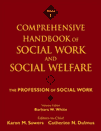Handbook Preface
The profession of social work spans more than 100 years. Over this period, the profession has changed in scope and depth. Despite the varied functions and methods of our profession, it has always been committed to social justice and the promotion of well-being for all. The profession has made great strides and is experiencing a resurgence of energy, commitment, and advancement as we face new global realities and challenges and embrace new and innovative technologies.
In considering how the field of social work has evolved over the past century with the resulting explosion of new knowledge and technologies, it seemed imperative to create a resource (Comprehensive Handbook of Social Work and Social Welfare) that provides a manageable format of information for researchers, clinicians, educators, and students. Our editors at John Wiley & Sons, the volume editors (Ira Colby, William Rowe, Lisa Rapp-Pagglici, Bruce Thyer, and Barbara W. White) and we as editors-in-chief, developed this four-volume handbook to serve as a resource to the profession.
The Comprehensive Handbook of Social Work and Social Welfare includes four volumes (The Profession of Social Work, Human Behavior in the Social Environment, Social Work Practice, and Social Policy and Policy Practice). Each volume editor did an outstanding job of assembling the top social work scholars from around the globe to contribute chapters in their respective areas of expertise. We are enormously grateful to the chapter authors who have contributed their expert knowledge to this work. Each volume includes a Preface written by the respective volume editor(s) that provides a general overview to the volume. In developing the Comprehensive Handbook, we attempted to focus on evidence supporting our theoretical underpinnings and our practice interventions across multiple systems. Content was designed to explore areas critically and to present the best available knowledge impacting the well-being of social systems, organizations, individuals, families, groups, and communities. The content is contemporaneous and is reflective of demographic, social, political, and economic current and emerging trends. Authors have paid close attention to contextual factors that shape the profession and will have a future impact on practice. Our profession strives to understand the dimensions of human difference that we value and engage to ensure excellence in practice. These dimensions of diversity are multiple and include factors such as disability, religion, race, culture, sexual orientation, social class, and gender. Each of the volumes addresses how difference characterizes and shapes our profession and our daily practice. New knowledge, technology, and ideas that may have a bearing on contemporary and future social work practice are infused throughout each of the volumes.
We challenged the chapter authors to not only provide an overview of specific content, but to feel free to raise controversial issues and debates within the profession. In the interest of intellectual freedom, many of our chapter authors have done just that in ways that are intriguing and thought provoking. It was our objective to be comprehensive but not encyclopedic. Readers wishing to obtain even greater specificity are encouraged to access works listed in the references for each chapter.
The Handbook's focus on evidence should assist the reader with identifying opportunities to strengthen their own understanding of the amount of science that does or does not support our social work theory and practice. Social work researchers must expand the scientific evidence that supports social work theory and practice as well as informing policy, and enhance their functional scope to overcome the more than 10-year lag between research and practice. We are rightfully proud of our social work history, and its future will be driven by our success in demonstrating that as a profession we can achieve credible and verifiable outcomes across the spectrum of services that utilize our skills. As a profession, we must assure we value science so that even the most vulnerable populations receive the best available services.
We hope that you find this Handbook useful. We have endeavored to provide you, the reader and user, with a comprehensive work that will serve as a guide for your own work in this wonderful profession. We welcome your comments and suggestions.
-
Karen M. Sowers
-
Catherine N. Dulmus



